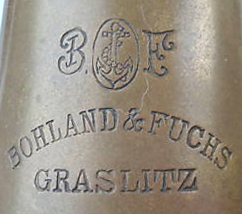
Horn-u-Copia's Display of Makers
Bohland & Fuchs
Graslitz
Czech Republic
1870-1945
Bohland and Fuchs (Graslitz, Czechoslovakia) are established as a partnership in 1870, following the firm of Gustavus Bohland, which had been founded 20 years earlier, and flourished until 1945 when the firm was nationalized. By 1925, they had a workforce of 500. They built a doublephon in 1891, a sub-contrass bass tuba which is the largest ever built in 1912, a double trombone, and a quarter-tone trumpet.

Bohland & Fuchs was established in Graslitz in Bohmen, a part of the Austrian-Hungarian Empire (therefore the German spelling: Graslitz). Thus, the early instruments by Bohland & Fuchs are all marked Austria.
Bohmen - or Bohemia in English - was the most industrialized part of the Empire, but the majority of the population were not of German origin (except for Sudetenland, where Graslitz is located). The Czechs under Austrian supervision and the Slovaks under Hungarian supervision worked for freedom and in October 1918 a declaration of Czechoslovakian independence was issued. The first Czechoslovakian republic existed from 1918 until 1938. Instruments from this era are signed Czechoslovakia. It seems like they still used the German spelling Graslitz during this time, as most of the inhabitants of Sudetenland were Germans at this time.
In September 1938. Germany under Hitler was given Sudetenland (with Graslitz) in the Munchen Agreement. Then, Sudetenland became a part of Germany. In 1939 what was left of Czechoslovakia also became part of Germany, the protectorate of Bohemia and Moravia. The few instruments from this German era (1938-1945) are signed Bohemia even though Graslitz did not belong to the protectorate. Correctly, they should have been Germany and maybe some were.
In 1945, after WWII, Sudetenland once again became Czechoslovakian and all musical instruments makers were centralized into one company. Amati (of Kraslice, Czech spelling of Graslitz). The new Czechoslovakian government did not want to be associated with things German, and most of the German population did flee to Germany. For example wind instrument makers the brothers Keilwerth, brass instrument makers Huttl and many craftsmen, for example, those forming Kuhnl & Hoyer. Therefore many early Keilwerth, K&H and other contemporary German brass instruments seem to be copies of Bohland & Fuchs brass instruments.
Some instruments are signed Czecho-Slovakia. It may be as simple as just a two-line word split, but If Bohland & Fuchs were following political decisions it may mean that these instruments were made 1918-1920. OR maybe during that short time, 1938-1939 before the remnants of Czechoslovakia became the protectorate of Bohemia and Moravia. If so, it is like those made 1938-1945 (or maybe 1939-1945 if these 1938-1939 are their predecessors) who are signed Bohemia.
It also seems like some earlier instruments are signed Bohemia. Even though the old Bohemia had been under Austrian rule for centuries it still existed as a juridical Kingdom. Therefore it is possible that those early Bohemia are post-1900, and possibly post 1914.
Potential dating scheme:
- at least from a date at or sometime after 1893, they used Austria.
- 1905-1918 they used Bohemia
- 1918 - 1920 they used Czecho-Slovakia
- 1920 to 1938, they used Graslitz Czecholovakia
- From 1938, they used Bohema.
Contribute new Data (or Corrections):
Information posted here will be added to this page.
This is not the place to ask questions, as users will only occasionally visit a particular Maker's
page. Pease use the forum to ask questions or talk about your instrument.
(Please use the forum for discussions, questions, etc.)

